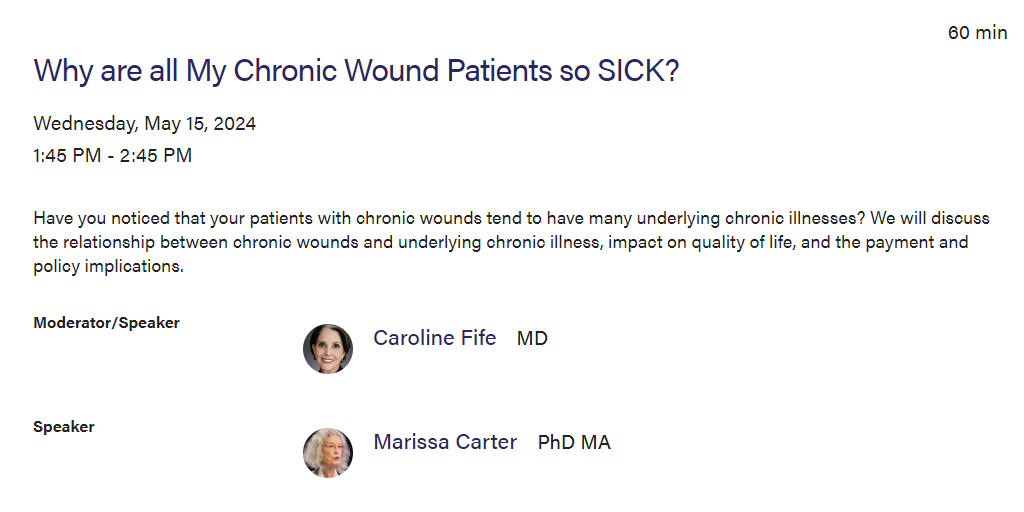If you are attending the SAWC Spring 2024 Conference next week, come listen to Dr. Marissa Carter and I discuss, “Why are all My Chronic Wound Patients so SICK?” The session is Wednesday May 15, from 1:45 PM – 2:45 PM Eastern, in Crystal K.
In the session, we will discuss the study that Dr. Carter, Kris Eckert and I published evaluating the underlying medical conditions in a sample of chronic wound patients.
This began a few years ago when I was testing the feasibility of a quality measure that could be reported by wound care practitioners as part of the Quality Payment Program (QPP). I had gotten the Centers for Medicare and Medicaid Services (CMS) to approve using the Wound-Quality-of-Life (W-QoL) questionnaire as a quality measure in the assessment of patients with non-healing wounds. The project was a lot of work and totally unfunded (as usual for any quality measure work!) – and it was a complete failure.
I provided the W-QoL questionnaire to a convenience sample of 382 patients seen at my hospital-based outpatient wound center (thanks to the help of my amazing nurses!). The patients used pre-programmed tablets to fill out the Q-QoL which transmitted the results electronically to the US Wound Registry where the W-QoL data were married with the rest of their medical record about their wound severity and outcome. We managed to get both initial visit and discharge questionnaires in about 100 patients, and we compared the results of the W-QoL with the outcome of treatment. There was no correlation between W-QoL and wound outcome, meaning, the W-QoL failed as a surrogate for wound outcome. We could not even correlate the sub-score about wound odor with the documented wound odor in the chart.
The primary reason that even wound healing was not correlated with a significant improvement in W-QoL is that the mean number of serious co-morbid conditions per patient was 8! What Kris Eckert and Dr. Carter then did was exhaustive research on what’s called the “utility score” (a measure of life impact “badness”) for each of the most common underlying medical conditions. In the world of “utility scores,” a score of 1 is perfect health and a score of 0 is death. Scattered over many different journals they found the utility score of most but not all of the major medical conditions from which the patients suffered. After a long and tedious analysis, they found that 229 of the patients (59.9%) had utility values for comorbidities/conditions which were worse/lower than their wounds’ values. In other words, their heart failure, paralysis, etc. made their life so miserable, it was impossible to measure the incremental misery of the wound(s) or the small improvement associated with healing. Sixty-three (16.5%) patients had depression and/or anxiety, 64 (16.8%) had morbid obesity, and 204 (53.4%) had gait and mobility disorders, all of which could have affected W-QoL scoring. In fact, the mean minimum utility value of their diseases was 0.5, which is not much different than the utility value of a chronic wound. In other words, at best, the life impact of the wound is about the same as their least severe underlying medical condition.
There was another reason that the W-QoL failed, and that’s because the average real-world patient has more than 2 wounds/ulcers. It wasn’t possible to know which of the several ulcers the patient had in mind when they answered the questionnaire. And logic would suggest that all the wounds/ulcers would need to be healed for them to have a significant improvement in W-QoL.
In case you are wondering, the following year, CMS rejected the quality measure I had designed that was focused on measuring quality of life. It is the position of CMS that simply measuring quality of life is not a “quality activity.” We would have to be able to show that quality of life was IMPROVED by some percentage at the conclusion of treatment. And since I could find no correlation at all between the W-QoL and wound outcome, there was no possibility of using QOL as a surrogate for wound outcome. I should also add that providing a QoL to wound care patients is time consuming and has associated costs for which there is no financial compensation. That’s why, when anyone asks me if US Wound Registry data has quality of life information, I get a little…aggressive… (Hint: If manufacturers want QoL data, they will have to pay for it to be collected.)
In the SAWC presentation next Wednesday, Dr. Carter and I will talk about the major comorbid diseases experienced by wound care patients, and what the data mean with regard to using quality of life as a surrogate endpoint for healing in the real world, as well as what the data mean to the reporting of wound healing rates. Make no mistake about it, the real issue here has to do with the reporting of wound healing rates in very sick people.
Hope to see you there!
–Caroline
Related Articles:
- Quality of Life in Patients with Chronic Wounds… and Yes, Our Patients are Very Sick
- Why Quality of Life Failed Miserably as a Surrogate Endpoint for Wound Outcome
- The Development of the Wound Quality of Life Questionnaire – and Why QOL is a Failure as a Surrogate of Wound Outcome

Dr. Fife is a world renowned wound care physician dedicated to improving patient outcomes through quality driven care. Please visit my blog at CarolineFifeMD.com and my Youtube channel at https://www.youtube.com/c/carolinefifemd/videos
The opinions, comments, and content expressed or implied in my statements are solely my own and do not necessarily reflect the position or views of Intellicure or any of the boards on which I serve.



